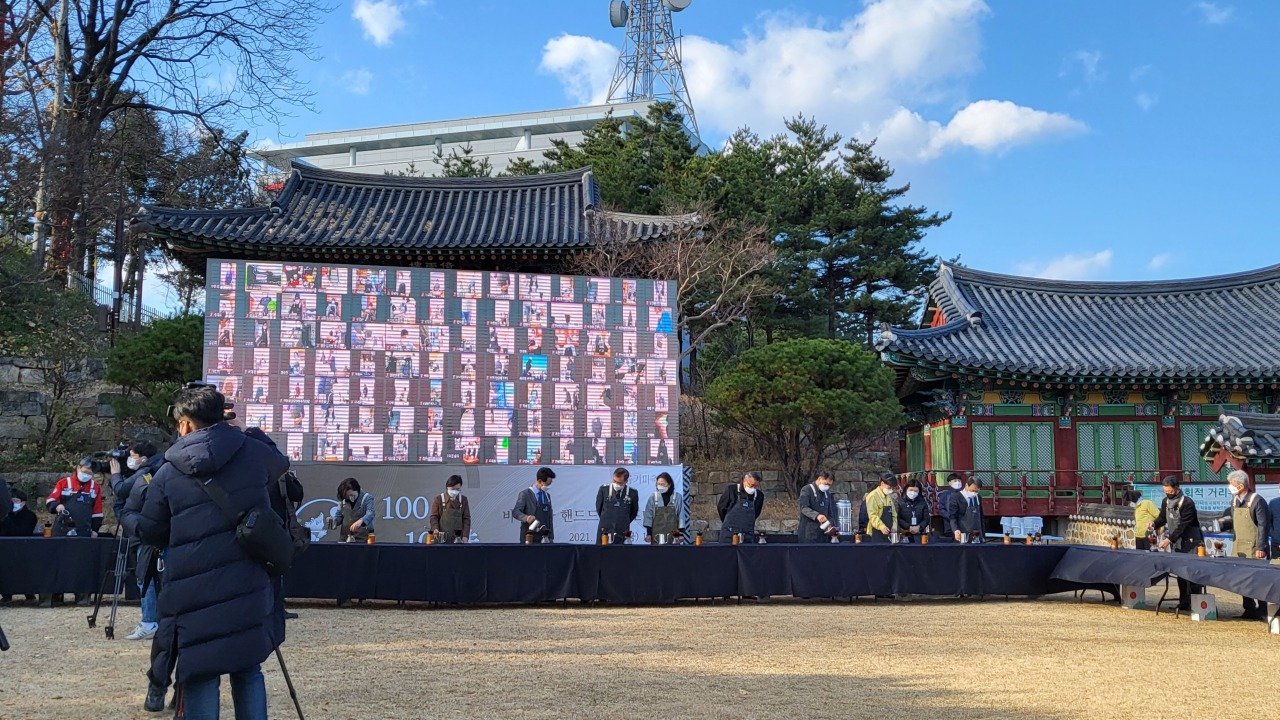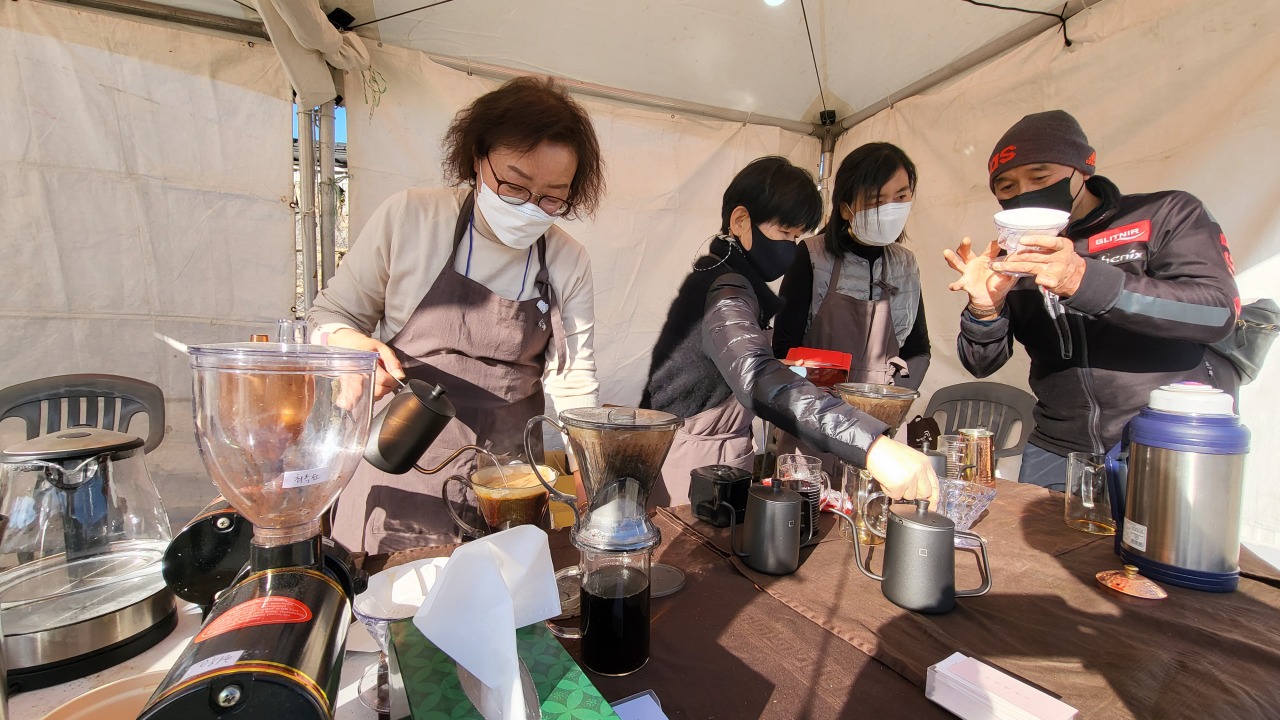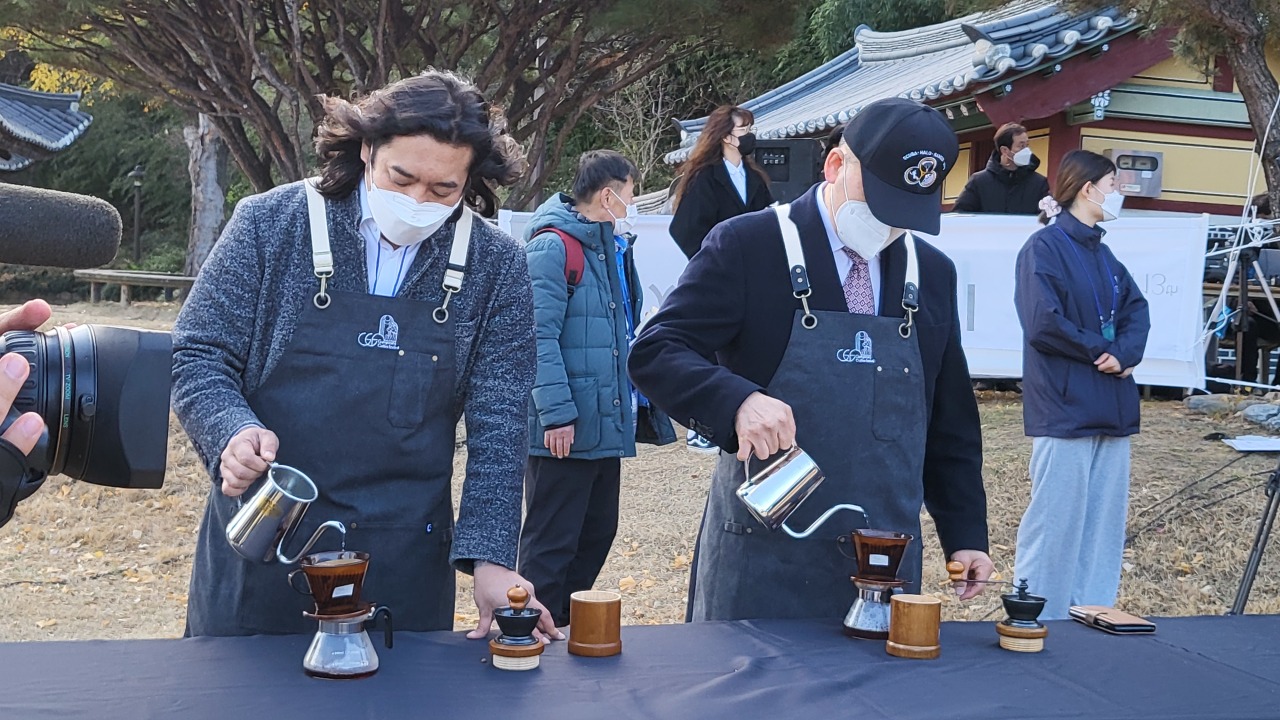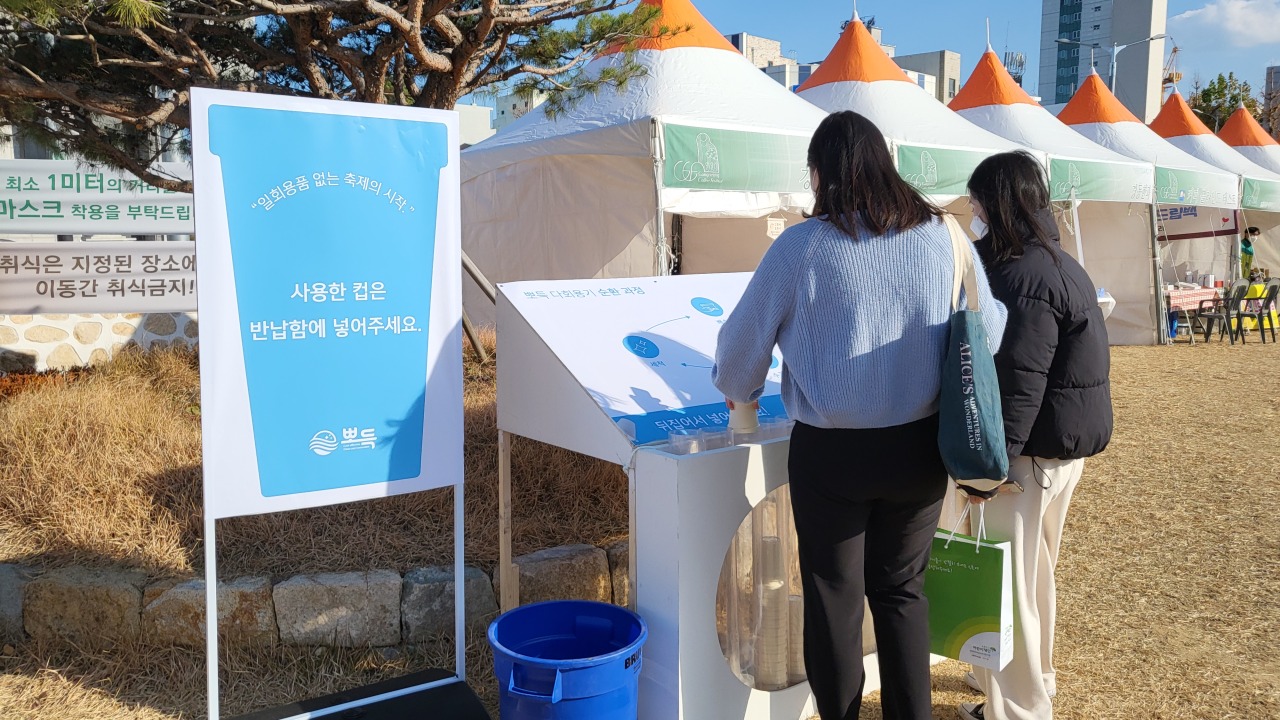Coffee lovers flock back to Gangneung for caffeine-loaded fest
By Kim Hae-yeonPublished : Nov. 28, 2021 - 20:54

GANGNEUNG, Gangwon Province -- After a two-year break forced by the pandemic, the long awaited Gangneung Coffee Festival returned for its 13th edition, Thursday to Sunday.
With the slogan, “Nonetheless, coffee,” some 80 coffee-themed booths were set up at Daedohobu Gwana, a site where central government officials from the capital visiting the region stayed during the Goryeo Kingdom and Joseon era.
Friday saw its signature program, “100 People 100 Tastes,” a massive simultaneous hand drip performance event. With 100 participants livestreaming online and 30 more in-person at the Daedohobu Gwana presenting their coffee extraction methods. On-site participants handed out the coffee to spectators after the performance.
“Compared to the 2019 festival, I can see how the public has become much more articulate about their taste preferences of coffee,” Lee Jun-hyeong, chair of the Gangneung Coffee Research Society, who also trains baristas in the city, told The Korea Herald on Saturday.
With the slogan, “Nonetheless, coffee,” some 80 coffee-themed booths were set up at Daedohobu Gwana, a site where central government officials from the capital visiting the region stayed during the Goryeo Kingdom and Joseon era.
Friday saw its signature program, “100 People 100 Tastes,” a massive simultaneous hand drip performance event. With 100 participants livestreaming online and 30 more in-person at the Daedohobu Gwana presenting their coffee extraction methods. On-site participants handed out the coffee to spectators after the performance.
“Compared to the 2019 festival, I can see how the public has become much more articulate about their taste preferences of coffee,” Lee Jun-hyeong, chair of the Gangneung Coffee Research Society, who also trains baristas in the city, told The Korea Herald on Saturday.

“Just a few years ago, 8 in 10 would have preferred dark-roasted nutty flavors, with pronounced bitterness. These days, aromatic and moderately acidic coffees are getting more spotlight,” Lee said. Visitors to the tasting event ask for specific types of bean, or aroma notes, and discuss the process of extraction in detail, according to Lee.
Yang jin-ho, president of the Gangneung Coffee Festival’s executive committee, hoped for more foreign visitors to come and enjoy the festival, showing confidence in the unique coffee culture of Korea.
“The festival has had an average of 500,000 visitors annually since its first opening in 2009. Koreans not only enjoy tasting coffee itself, but love spending time with a cup of coffee in a cozy atmosphere. I believe Gangneung is a city that has such value, since it maintains traditional streets and houses on every corner, along with cafes.” Yang told The Korea Herald.
Yang also mentioned the city’s strong passion and growing interest in specialty coffee. “Cafes and baristas concentrating on specialty coffee are rapidly growing in size. Global coffee experts are also looking into Korea’s coffee industry with potential in specialty coffee.” Yang added.
Yang jin-ho, president of the Gangneung Coffee Festival’s executive committee, hoped for more foreign visitors to come and enjoy the festival, showing confidence in the unique coffee culture of Korea.
“The festival has had an average of 500,000 visitors annually since its first opening in 2009. Koreans not only enjoy tasting coffee itself, but love spending time with a cup of coffee in a cozy atmosphere. I believe Gangneung is a city that has such value, since it maintains traditional streets and houses on every corner, along with cafes.” Yang told The Korea Herald.
Yang also mentioned the city’s strong passion and growing interest in specialty coffee. “Cafes and baristas concentrating on specialty coffee are rapidly growing in size. Global coffee experts are also looking into Korea’s coffee industry with potential in specialty coffee.” Yang added.

Two reasons are frequently cited for the far-reaching fame of Gangneung’s coffee: the region’s clean water and the popularity of instant coffee vending machines in the 1980s.
Since the time of the Silla Kingdom (57 BC-935), tea culture has been prominent in Gangneung, a coastal town on the east coast known for the quality of its water.
Historical records show that coffee landed in Korea in the early 1860s. Emperor Gojong enjoyed drinking coffee at Deoksugung, his palace near today’s City Hall in Seoul, while receiving important guests. The first coffee advertisement in the nation was published in Tongnip Sinmun, also known as the Independent, in September 1896, when a German merchant opened a shop in Jeong-dong, a diplomatic enclave in Seoul.
Some 100 years later in the early 1980s, coffee’s popularity reached the east coast city of Gangneung along the scenic Anmok Beach, where instant and canned coffee vending machines proliferated.
A decade later, the first hand drip cafes opened, also along the beach, attracting visitors with full-flavored coffee. Some of Korea’s legendary coffee brewers settled down in Gangneung during this time.
This year, an online program called Gangneung Coffee Live Commerce was inaugurated, selling beans, drip bags, coffee buns and other coffee-related products through online platforms Naver and Kakao Page.
On site, around 40,000 multiuse cups were prepared to be given out to festival visitors and returned later to relevant companies for reuse.
Since the time of the Silla Kingdom (57 BC-935), tea culture has been prominent in Gangneung, a coastal town on the east coast known for the quality of its water.
Historical records show that coffee landed in Korea in the early 1860s. Emperor Gojong enjoyed drinking coffee at Deoksugung, his palace near today’s City Hall in Seoul, while receiving important guests. The first coffee advertisement in the nation was published in Tongnip Sinmun, also known as the Independent, in September 1896, when a German merchant opened a shop in Jeong-dong, a diplomatic enclave in Seoul.
Some 100 years later in the early 1980s, coffee’s popularity reached the east coast city of Gangneung along the scenic Anmok Beach, where instant and canned coffee vending machines proliferated.
A decade later, the first hand drip cafes opened, also along the beach, attracting visitors with full-flavored coffee. Some of Korea’s legendary coffee brewers settled down in Gangneung during this time.
This year, an online program called Gangneung Coffee Live Commerce was inaugurated, selling beans, drip bags, coffee buns and other coffee-related products through online platforms Naver and Kakao Page.
On site, around 40,000 multiuse cups were prepared to be given out to festival visitors and returned later to relevant companies for reuse.

The city promoted the festive atmosphere of Gangneung by illuminating at night the Ojukheon house, a historical site where Shin Saimdang (1504-1551), a well-known artist, writer, calligrapher and poet, and her son Yulgok Yi I, a prominent neo-Confucian scholar, lived.
By Kim Hae-yeon (hykim@heraldcorp.com)
By Kim Hae-yeon (hykim@heraldcorp.com)








![[Graphic News] More Koreans say they plan long-distance trips this year](http://res.heraldm.com/phpwas/restmb_idxmake.php?idx=644&simg=/content/image/2024/04/17/20240417050828_0.gif&u=)
![[KH Explains] Hyundai's full hybrid edge to pay off amid slow transition to pure EVs](http://res.heraldm.com/phpwas/restmb_idxmake.php?idx=644&simg=/content/image/2024/04/18/20240418050645_0.jpg&u=20240419100350)






![[From the Scene] Monks, Buddhists hail return of remains of Buddhas](http://res.heraldm.com/phpwas/restmb_idxmake.php?idx=652&simg=/content/image/2024/04/19/20240419050617_0.jpg&u=20240419175937)

![[KH Explains] Hyundai's full hybrid edge to pay off amid slow transition to pure EVs](http://res.heraldm.com/phpwas/restmb_idxmake.php?idx=652&simg=/content/image/2024/04/18/20240418050645_0.jpg&u=20240419100350)

![[Today’s K-pop] Illit drops debut single remix](http://res.heraldm.com/phpwas/restmb_idxmake.php?idx=642&simg=/content/image/2024/04/19/20240419050612_0.jpg&u=)